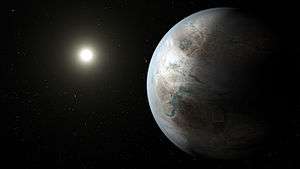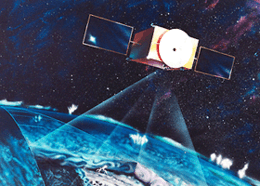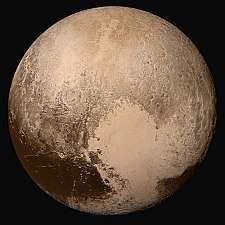Aldebaran b
| Exoplanet | List of exoplanets | |
|---|---|---|
 | ||
| Parent star | ||
| Star | Aldebaran | |
| Constellation | Taurus | |
| Right ascension | (α) | 04h 35m 55.23907s[1] |
| Declination | (δ) | +16° 30′ 33.4885″[1] |
| Apparent magnitude | (mV) | 0.86[2] (0.75-0.95) |
| Distance | 65 ly (20 pc) | |
| Spectral type | K5 III[3] | |
| Mass | (m) | 1.16±0.07[4] M☉ |
| Radius | (r) | 44.2±0.9 R☉ |
| Temperature | (T) | 3,910 K |
| Age | 6.4±1.4[4] Gyr | |
| Physical characteristics | ||
| Mass | (m) | 5.8±0.7[4] MJ |
| Temperature | (T) | 1,500 K (1,230 °C; 2,240 °F) |
| Orbital elements | ||
| Semi-major axis | (a) | 1.46 ± 0.27 AU |
| Periastron | (q) | 1.314 +0.3295 −0.3025 AU |
| Apastron | (Q) | 1.606 +0.2105 −0.2375 AU |
| Eccentricity | (e) | 0.1 ± 0.05 |
| Orbital period | (P) | 628.96 ± 0.9 d |
| Argument of periastron |
(ω) | 287 ± 29° |
| Time of periastron | (T0) | 1999/04/28 ± 50 JD |
| Discovery information | ||
| Discovery date | 1993 (dubious) May 15, 2015 (confirmed) | |
| Discoverer(s) | ||
| Discovery method | Radial velocity | |
| Discovery status | ||
Aldebaran b is an exoplanet orbiting the orange giant star Aldebaran, 65 light-years away. It was initially detected in 1993, but was considered doubtful until in 2015, when researchers came to a conclusion that there is likely an exoplanet orbiting Aldebaran, consistent with the original calculations, but also compatible with stellar activity.[5]
Characteristics
Mass and orbit
Aldebaran b is a giant exoplanet with about 6.5 times the mass of Jupiter. It orbits at a distance about 45% farther than Earth does from the Sun. The equilibrium temperature of this planet is likely to be around 1,500 K (1,230 °C; 2,240 °F), as it is strongly irradiated by its giant host star. Nevertheless, when Aldebaran was a main sequence star, it is likely that the planet had an equilibrium temperature comparable to that of the Earth.[4]
Host star
The host star, Aldebaran, is an orange giant star, meaning it has moved off from the main sequence and exhausted the supply of hydrogen in the core. It has a spectral class of K5 III.[3]
Aldebaran is a K-type star that is 1.16 ± 0.07 times the mass[4] and 44 times the radius of the Sun. It has a surface temperature of 3,910 K. In comparison, the Sun has a surface temperature of 5778 K.[6]
The star's apparent magnitude, or how bright it appears from Earth's perspective, is 0.86. Therefore, Aldebaran is visible to the naked eye.
Discovery
1993 proposal
The exoplanet was first proposed in 1993, radial velocity measurements of Aldebaran, Arcturus and Pollux showed that Aldebaran exhibited a long-period radial velocity oscillation, which could be interpreted as a substellar companion. The measurements for Aldebaran implied a companion with a minimum mass 11.4 times that of Jupiter in a 643-day orbit at a separation of 2.0 AU (300 Gm) in a mildly eccentric orbit. However, all three stars surveyed showed similar oscillations yielding similar companion masses, and the authors concluded that the variation was likely to be intrinsic to the star rather than due to the gravitational effect of a companion.[7]
2015 confirmed status
In 2015, a study showed stable long-term evidence for both a planetary companion and stellar activity.[8]
See also
References
- 1 2 Van Leeuwen, F. (2007). "Validation of the new Hipparcos reduction". Astronomy and Astrophysics. 474 (2): 653. arXiv:0708.1752. Bibcode:2007A&A...474..653V. doi:10.1051/0004-6361:20078357.
- ↑ Ducati, J. R. (2002). "VizieR Online Data Catalog: Catalogue of Stellar Photometry in Johnson's 11-color system". CDS/ADC Collection of Electronic Catalogues. 2237: 0. Bibcode:2002yCat.2237....0D.
- 1 2 Gray, R. O.; Corbally, C. J.; Garrison, R. F.; McFadden, M. T.; Bubar, E. J.; McGahee, C. E.; O'Donoghue, A. A.; Knox, E. R. (2006). "Contributions to the Nearby Stars (NStars) Project: Spectroscopy of Stars Earlier than M0 within 40 pc-The Southern Sample". The Astronomical Journal. 132: 161. arXiv:astro-ph/0603770. Bibcode:2006AJ....132..161G. doi:10.1086/504637.
- 1 2 3 4 5 Farr, W. "Aldebaran b's temperate past uncovered in planet search data". arXiv:1802.09812. Bibcode:2018arXiv180209812F.
- ↑ Hatzes, A.P.; et al. (May 15, 2015). "Long-lived, long-period radial velocity variations in Aldebaran: A planetary companion and stellar activity": 18. arXiv:1505.03454. Bibcode:2015yCat..35800031H. doi:10.1051/0004-6361/201425519.
- ↑ Fraser Cain (15 September 2008). "Temperature of the Sun". Universe Today. Retrieved 19 February 2011.
- ↑ Hatzes, A.; Cochran, W. (1993). "Long-period radial velocity variations in three K giants". The Astrophysical Journal. 413 (1): 339–348. Bibcode:1993ApJ...413..339H. doi:10.1086/173002.
- ↑ Hatzes, A. P.; Cochran, W. D.; et al. "Long-lived, long-period radial velocity variations in Aldebaran: A planetary companion and stellar activity". arXiv:1505.03454. Bibcode:2015A&A...580A..31H. doi:10.1051/0004-6361/201425519.


